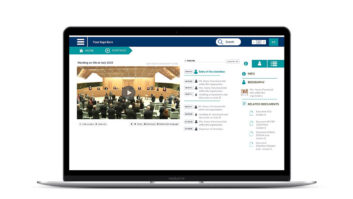2012 CEDIA Future Technology Pavilion Concepts Come Alive
May 20, 2013 12:46 PM
Remember CEDIA EXPO 2012? Dust off the cobwebs to think about that week. Lots of great products, parties, people and maybe even a visit to the Future Technology Pavilion? Sound familiar?
Visitors to last year’s CEDIA Future Technology Pavilion were able to see what the home of 2016 would look like. Ringing any bells? As we move toward 2016 technologies are building momentum, one of the key concepts discussed in the 2012 Future Technology Pavilion is coming closer to fruition. Do I have your attention now?
Telepresence
Yeah those faces on the big screen that looked a little nicer than when you skype your sister across the country on your MacBook, that was telepresence. A more formal definition of telespresence is: the highest levels of video communications that employ improved reliability of both sight and sound, creating the illusion of being physically present.
Telepresence is a viable solution for the large part of the population who work from home but still need some form of communication beyond phone calls and emails. 3.1 million people, (not including the self-employed or unpaid volunteers) consider home their primary place of work*. The influx of people working at home has created a demand for high end video conferencing systems to be installed in the home. Commercial technology professionals are probably well versed in what a video conferencing system may look like, but Telepresence is not easy to achieve.
So how do you start installing these systems?
Let’s start with video conferencing, of which telepresence is a highly refined subset. What are the essential elements of a video conferencing system?
a. Room: Lighting, décor, acoustics, ergonomics, usability and comfort
b. Camera: Video camera or webcam
c. Microphone: Dedicated table-top, head-mounted or built-in
d. Monitor: Flat-panel display, projection or desktop monitor
e. Speaker: Clear, voice-quality speakers, sometimes built into dedicated, table-top microphones
f. Codec (Coder/Decoder): Dedicated hardware and/or software
g. Data Sharing: Connectivity for embedded presentations from VGA, DVI, HDMI, white boards and wireless sources
h. User Interface: Often built into the codec
i. Network: Robust, secure, high-bandwidth IP network and Internet connectivity
j. TCO: Total cost of ownership, an important consideration for delivering a long-term, complete solution
Telepresence adds emphasis to all of these elements in order to enhance the sense of immediacy, immersion and collaboration. Let’s look at one of the major components of executing telepresence, and a topic that we’ve been discussing for some time: the network.
Latency is a major factor in network design for telepresence. The total network latency target is 150 ms or less. This figure would be for total network flight time, not including codec processing time. During your needs assessment, it’s important to determine available bandwidth on the network and Internet data rates. Network usage will vary through the day, so make sure bandwidth is available whenever the video conferencing equipment will be in use, particularly during multi-party conferences, which use considerably more data.
The network is just one of the parts of executing a telepresence project. Telepresence requires expert implementation of the human sensory qualities of audio, video, and environment. CEDIA covers each of these design components listed above in greater detail in the new white paper “Telepresence Opportunities for Home Technology Professionals.” CEDIA members may access their complimentary copy through the CEDIA Marketplace at www.cedia.net/marketplace , non-members may purchase a copy for $9.99.
*Global Workplace Analytics. (2011, June). The State of Telework in the U.S. website: http://www.globalworkplaceanalytics.com/telecommuting-statistics










